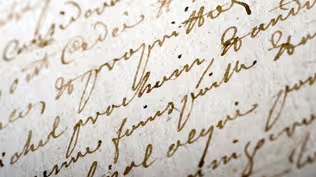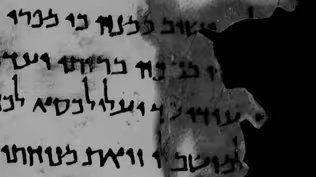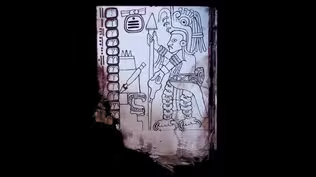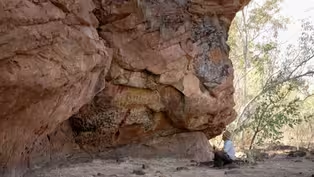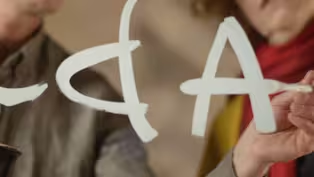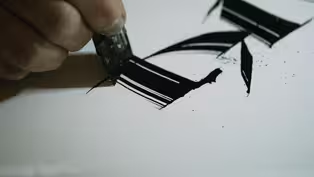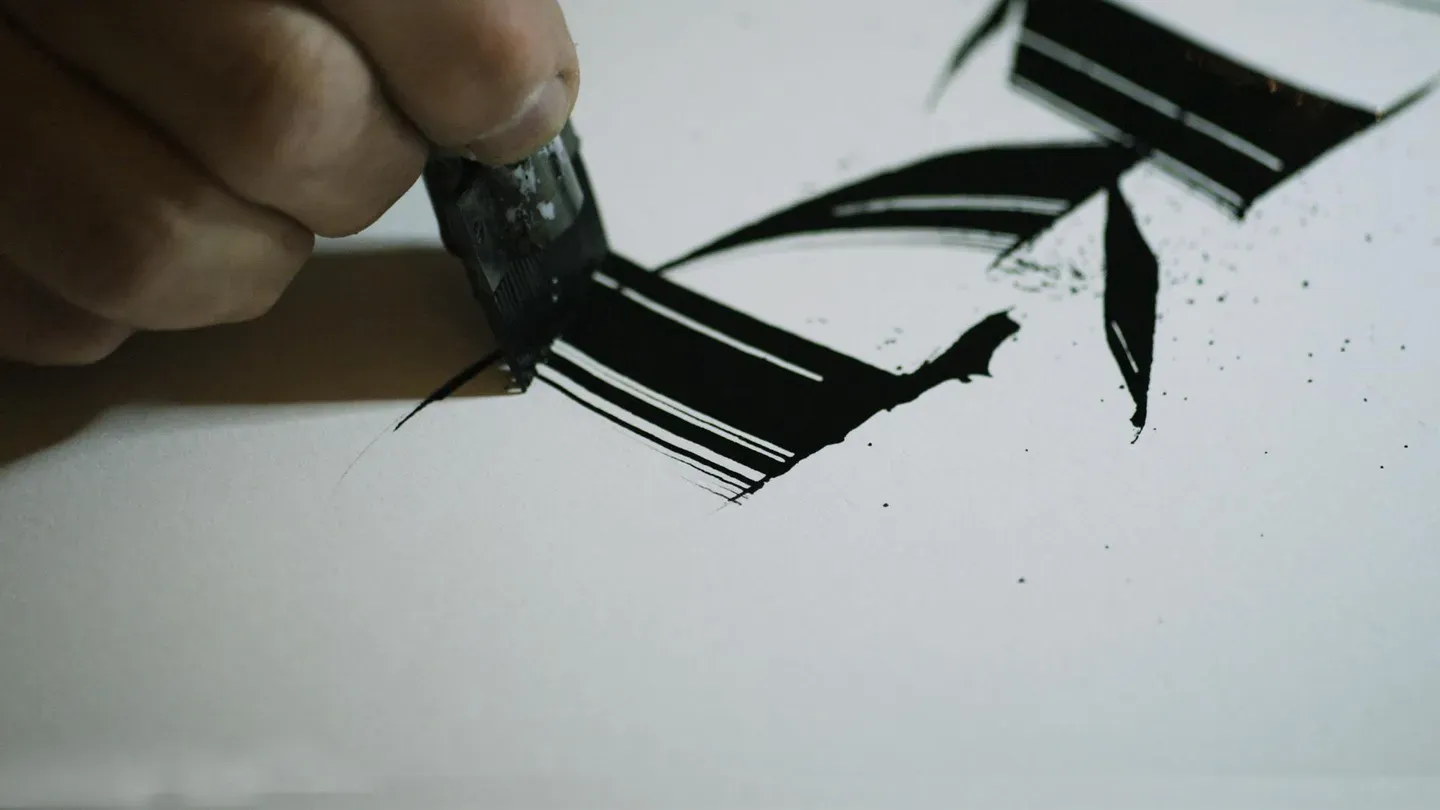

A to Z: The First Alphabet
Season 47 Episode 13 | 54m 2sVideo has Audio Description, Closed Captions
The birth of writing and the first alphabet were among the world’s most vital inventions.
Writing shaped our world and the rise of human knowledge, from the trading of goods to tales of ancient goddesses and kings. Follow the evolution of the written word, from 4,000-year-old carvings in an Egyptian turquoise mine to modern-day alphabets.
See all videos with Audio DescriptionADProblems playing video? | Closed Captioning Feedback
Problems playing video? | Closed Captioning Feedback
Additional funding for "The First Alphabet" is provided by the George D. Smith Fund. Major funding for NOVA is provided by the David H. Koch Fund for Science, the Corporation...

A to Z: The First Alphabet
Season 47 Episode 13 | 54m 2sVideo has Audio Description, Closed Captions
Writing shaped our world and the rise of human knowledge, from the trading of goods to tales of ancient goddesses and kings. Follow the evolution of the written word, from 4,000-year-old carvings in an Egyptian turquoise mine to modern-day alphabets.
See all videos with Audio DescriptionADProblems playing video? | Closed Captioning Feedback
How to Watch NOVA
NOVA is available to stream on pbs.org and the free PBS App, available on iPhone, Apple TV, Android TV, Android smartphones, Amazon Fire TV, Amazon Fire Tablet, Roku, Samsung Smart TV, and Vizio.
Buy Now
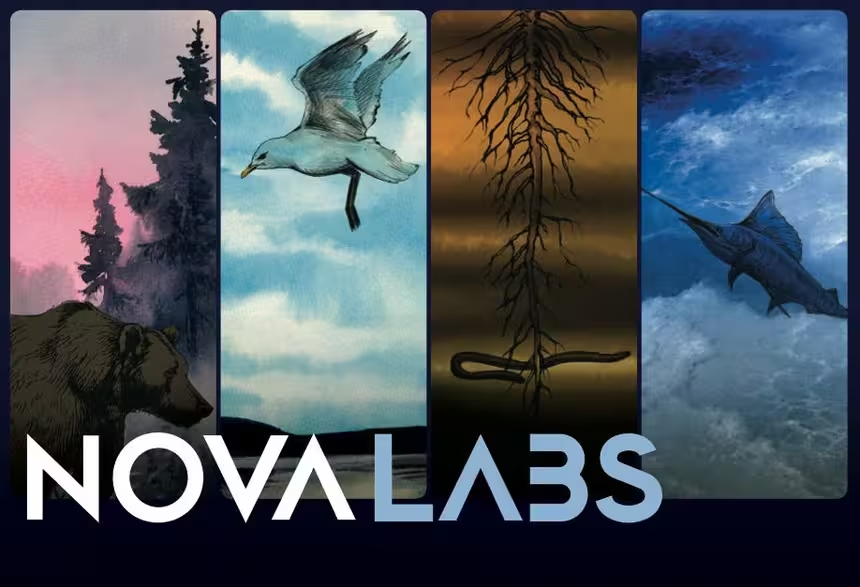
NOVA Labs
NOVA Labs is a free digital platform that engages teens and lifelong learners in games and interactives that foster authentic scientific exploration. Participants take part in real-world investigations by visualizing, analyzing, and playing with the same data that scientists use.Providing Support for PBS.org
Learn Moreabout PBS online sponsorship♪ ♪ NARRATOR: It's our most important tool, one we all take for granted: writing.
There are dozens of ways to do it in hundreds of languages.
Symbols and alphabets to capture human thought and history.
Oh, wow!
NARRATOR: With more in common than we think.
YONGSHENG CHEN: Egyptian and Chinese writing are very comparable.
When I started to learn Egyptian hieroglyphs, I could feel that.
So many similarities.
NARRATOR: And yet, writing hasn't always existed.
It had to be invented.
IRVING FINKEL: When you scrutinize what happened, it is actually very dramatic, the giant leap for mankind.
NARRATOR: What were the first records to record human history?
Writing always starts with pictures.
FINKEL: It's drawn quite recognizably as a pictographic sign.
So, anybody who saw that in ancient Mesopotamia would say, "Ah, barley!"
NARRATOR: The incredible story of writing can finally be told.
PIERRE TALLET: You have in front of you one of the first A of history, followed by one of the first Bs of the history, also.
LYDIA WILSON: Literally, alphabet.
Literally, alphabet.
NARRATOR: "A to Z: The First Alphabet."
Right now, on "NOVA."
♪ ♪ ♪ ♪ NARRATOR: The Sinai Desert.
1,300 feet above the sand dunes rises the plateau of Serabit El-Khadim.
And at the edge of the plateau lie the ruins of an ancient Egyptian temple.
This site may not be as famous as the pyramids, but it holds far greater significance for our history.
♪ ♪ TALLET (speaking French): NARRATOR: 4,000 years ago, a group of migrant workers were led here by a man riding on a donkey.
What they did in this place would transform the most important technology human beings have ever invented, one we all use every single day.
This technology allows us to teleport our thoughts into another person's brain across space and time.
It makes smartphones and computers possible, and yet it is thousands of years old.
It is the ancient technology of writing, and its story is the story of civilization itself.
♪ ♪ (scroll raveling) Egypt.
The Saqqara funerary complex near Cairo.
In 2300 BC, what today looks like a hill of sand was the pyramid tomb of Pharaoh Teti.
Inside the tomb, Egyptologist Yasmin El Shazly brings historian Lydia Wilson to see something extraordinary.
Oh, wow!
Yeah, they're pretty impressive, aren't they?
They really are.
EL SHAZLY: Yeah.
NARRATOR: The walls of Teti's tomb are carved with thousands of stylized pictures.
But this is not decoration.
EL SHAZLY: This is the earliest known complete text, ancient Egyptian text.
WILSON: Just beautiful.
NARRATOR: These pictures are hieroglyphs, a writing system older than the pyramids themselves.
And what do they say?
They are spells that help resurrect the king in the afterlife.
NARRATOR: The king's name is repeated again and again in every incantation.
PRIEST (dramatized): Oh!
Oh!
Rise up, oh, Teti.
Take your head, collect your bones.
Gather your limbs, shake the earth from your flesh.
Take your bread that rots not, your beer that sours not.
Stand at the gates that bar the common people.
Rise up, oh, Teti.
You shall not die.
Wow!
Oh, there's so much writing.
EL SHAZLY: Yes, these are all magic spells... Mm-hmm.
Designed to resurrect the king so he could live forever in the afterlife.
Mm-hmm.
The fact that his name is still there made him, in a sense, immortal; we're speaking about him right now.
(chuckles) EL SHAZLY: And the ancient Egyptians realized that; they realized that the written word had so much power, and that by writing your name, you became immortal, you immortalized yourself.
Mm-hmm.
NARRATOR: Hieroglyphs are indeed magic.
They may not raise the dead, but like all writing, they allow them to speak.
BRODY NEUENSCHWANDER: Writing is one of the few things that all societies do.
Everybody uses a pen, or a brush, and with that, we can express all of our thoughts, record all of our information, study the stars and compose poems, and write letters to each other.
So, writing binds humanity together practically more than any other activity.
NARRATOR: Today we take it for granted, but writing is arguably the most powerful idea we humans have ever come up with.
FINKEL: When you scrutinize what happened, it is actually very dramatic in one important sense, what we like to call in our department "the giant leap for mankind."
GÜNTER DREYER (in German): EL SHAZLY (voiceover): Writing always starts with pictures, and then it becomes a little bit more complicated, and that's how you develop into a purely alphabetic system later on.
NARRATOR: How did our ancestors conceive of writing?
How did they learn to make pictures speak, and how did those pictures eventually become the letters we use today?
The answers to those questions can only be found in an archaeology of the human mind.
(scroll raveling) Writing is a recent innovation.
Our species has existed for about 300,000 years, and for all but the last 5,000 of them, people had to record and transmit vital knowledge without the aid of writing.
Some cultures still do.
(percussion instrument tapping) (singing in world language) NARRATOR: In the Northern Territory of Australia, Yidumduma Bill Harney, an elder of the Wardaman people, is singing an ancient song about the creation of the world.
(singing) (singing) (singing and tapping) (song ends) All these song line trails that were made, happening all the way right back from the beginning of everything, to people, to people, to people, all the way right back billion, billion years ago, to million years, come down to hundred years, and now, now come back to, right up to us.
And we know all the song now.
That is why we'll never throw that creation song away.
We still got it there today.
(wildlife chittering) In a song line trail, there is the knowledge that is given to you from the old people, in what they call song line trails, for naming all the different sites, the plants, trees, mountains, water hole, and all of that.
Like a map, it is a map, in your mind.
It all links up.
NARRATOR: Aboriginal culture has been handed down orally through poetry and song for tens of thousands of years, without the need to write anything down.
So, the first question about writing is, why did our ancestors feel the need for it?
What prompted them to start recording things not for the ear, but for the eye?
Images, of course, are part of all human cultures.
In the site now where we're sitting down, it's called the moon dreaming site.
That's the moon that you can see there, that's the half moon, and the Aboriginal name is called Jabali, and that's the headdress he used.
NARRATOR: In the Wardaman Creation story, all the plants and animals of the world were once people, the Wardaman's ancestors, wandering across a formless muddy land, until the Creation dog let out a mighty howl.
(dogs howling) When he sung out... (imitating) like this, the dog's the one that sound that made everything change.
He changed the whole world.
And this country now, from the soft high mound become a rock, and all these people become a tree, and changed into all the different animals-- kangaroos, dingoes, whatever you can make it, lizards and snakes, and all.
NARRATOR: As the mud hardened, some of the ancestors passed into the rock, leaving traces of that moment of Creation.
HARNEY: That was the mud, and people come along and put his foot there.
See?
And that's what it is there.
He was in the mud, now he's in the rock.
Human footprints, human there.
There is a dog there.
Then there is all human footprints, all over, you can see it.
Then the shadow of the old moon, who went into all of the rock, as well, during the Creation time.
(singing and tapping) NARRATOR: At the moon dreaming site, Bill can sing to his ancestors.
(Harney singing) For these are not representations of them, these are the ancestors, gone into the rock.
(Harney singing) NARRATOR: But Bill sings from memory.
These images, powerful as they are, cannot tell him which words to use.
For images to do that, they would have to gain a new power, the power to represent something else.
(scroll raveling) ♪ ♪ Cairo's Egyptian Museum is crammed with thousands of objects excavated from the tombs of ancient Egypt.
One of the very oldest was discovered by Günter Dreyer in the 1990s at a dig in the city of Abydos.
It's a clay vase which pre-dates the first pharaoh by many centuries.
It was made 5,700 years ago.
And it seems to use imagery in a new way.
(in German): NARRATOR: Günter believes that the vase is decorated with a stylized representation of the distinctive geography of the Nile Valley.
(kids playing) Egyptians have always lived on the land immediately adjacent to the Nile, where irrigation ditches can bring river water to the fields.
Ancient Egyptian life was largely confined to this narrow strip of green; the desert highlands on either side were where the dead were buried.
DREYER (in German): NARRATOR: So, these lines represent something, something that is not present.
It's a conceptual revolution in the meaning of a picture.
And if a picture can represent a thing, it can represent a word.
(in German): NARRATOR: But what was it that made people want to represent words in visual form?
5,000 years ago, Egypt lay at one end of a zone of cultivation called the Fertile Crescent.
At the other end lay Mesopotamia, modern day Iraq.
In both places, people had learnt how to irrigate the land to increase food production.
That meant that not everyone had to work the land, and a more complex society could develop.
Irving Finkel from the British Museum is an expert on Mesopotamia and the region's first civilization, Sumer.
FINKEL: To set the scene, it's important to understand that in Mesopotamia, the Sumerians had what we call city states-- independent walled entities with a large population, farmers all around, administrators, a central temple, and so forth.
And it is in those enclaves of so-called civilization that the need was, I think, first felt for some kind of record keeping.
And, of course, the thing about human ingenuity is that when there's a sharp need for something, it tends to crystallize in discovery.
NARRATOR: The need was to tally up food production so that it could be taxed and distributed to the cities.
The means of doing so were handy clay tablets on which the Sumerians could easily make marks, some of which would be familiar to any bookkeeper today.
This material goes from near the beginning of writing, so this is what we call a pictographic tablet from 3000 BC.
It's very slim and it's ruled into columns with boxes of information that go together.
These round and semi-round elements are numerals.
And in each of the boxes, they have these things, which are added up at the end.
NARRATOR: This clay tablet is the distant ancestor of today's spreadsheet: a grid of boxes with symbols that represent numbers, and pictures that represent commodities.
FINKEL: And this is the sign for barley, which is drawn quite recognizably as a pictographic sign.
So, anybody who saw that in ancient Mesopotamia would say, "Ah, barley."
NARRATOR: Such pictograms would be the basic building blocks of the first writing systems, and thousands of tablets like this one suggest that the reason for moving beyond a purely oral culture was something utterly prosaic: the need to keep ledgers.
As far as we can tell from the evidence, for several centuries, the use of pictograms was limited to primitive accountancy.
But then, sometime around 3000 BC, there was the crucial conceptual leap.
(scroll raveling) FINKEL: The giant leap came when somebody conceived of this matter: that you could draw a picture which represented something that someone could recognize, but at the same time, that sign could be used just for the sound of the thing it looked like.
So, on this tablet here, there is an ear of barley.
Now the word for barley in Sumerian is, is pronounced like "sheh."
So your Sumerian sees this and says "Ah, sheh, barley."
But at the same time, this scribe or a fellow scribe, in writing a totally different kind of document, could use this sign not to mean barley but just to write the sound of "sheh."
And this giant leap is something rather simple, and it's something which could have occurred to a child, but nevertheless it is of great lasting significance.
NARRATOR: Using a picture to represent a sound in this way is called the rebus principle, and it allows pictures to spell out words.
FINKEL: To give a really clear example, there's a word "shega" in Sumerian, which means "beautiful" or "pretty" or "nice" or something like that.
And so a scribe would write it syllabically, "she-ga." So, he would use this sign, the barley sign, for the "she" bit, and then he'd have to write "ga" for the second bit.
As it happens, "ga" means milk.
So, he would draw the picture which represented milk.
And barley and milk together would spell "shega," which had nothing to do with either barley or milk.
So, this is a kind of rebus writing.
Rebus is a smart word for it.
It's really a pun in some sense.
It is a kind of pun, that you get another meaning out of the sign.
(scroll raveling) NARRATOR: But what about the Egyptians?
It seems that they made the same giant leap at about the same time.
The evidence comes from an extraordinary object in Cairo's Egyptian Museum: the Narmer Palette, carved in 3000 BC.
DREYER (in German): NARRATOR: By conquering the Nile Delta, Narmer took control of the river all the way to the sea, becoming the first pharaoh of a unified Egyptian state.
The palette tells the story entirely through pictures.
(in German): NARRATOR: But next to the main characters in this grisly tale are seemingly random pairs of images, such as a catfish and a chisel.
They only make sense in light of the rebus principle.
DREYER (in German): NARRATOR: The Egyptian word for catfish is "nar" and chisel is "mer."
When combined, they sound out Narmer: the name of the first of the pharaohs.
Next to his defeated enemy is the symbol for a harpoon, "war" in Egyptian.
Below it is a rectangle, similar to the ones on the Abydos vase.
DREYER (in German): (scroll raveling) ♪ ♪ NARRATOR: The next step was to extend the rebus principle, which on the Palette is used to spell names, to the full vocabulary of the Egyptian language.
In doing so, the Egyptians created what was possibly the world's first true writing system, a complex and beautiful script: hieroglyphs.
Orly Goldwasser has made them a lifetime's study.
ORLY GOLDWASSER: This is the greatest experiment ever conducted to write language in pictures only, only pictures.
It's an enormous cognitive effort to read it or to write it, but it's fantastic.
NARRATOR: What makes hieroglyphs difficult is that Egyptian scribes used thousands of different symbols, and the rebus means that many of them have at least two different meanings.
If we are talking about a duck, as you see it here, it can be a representation of a duck.
And this is fine, this is easy.
But, in many other cases, he is not a duck at all.
He is just the sound of the duck: "soh."
For example, the word "daughter" is "soht" or something like that.
We don't know exactly how to pronounce that.
So, for the "soh," we have our dear duck.
And afterwards we put another sign, something that looks like a small half French bread, you see it?
Cut French bread, which gives the meaning "tuh."
So, "soht."
♪ ♪ NARRATOR: The rebus principle was the key that unlocked writing for the peoples of the Fertile Crescent.
With pictures that spoke, rulers could write the history of their reigns, draw up legal codes, administer far-flung empires, and build monuments that still impress us today.
The rebus is arguably the most consequential intellectual innovation of all time.
So, who invented it?
DREYER: True writing starts when the sounds of a language are represented.
And that, I think, was first developed in Egypt.
And, of course, there's a bit of a squabble between Egyptologists and Assyriologists about who invented writing, and, of course, we did.
It's an important thing to clarify.
♪ ♪ NARRATOR: Squabbling aside, where was the rebus born-- in Egypt or Mesopotamia?
Or somewhere else entirely?
(scroll raveling) ♪ ♪ In the Beijing Huijia Private School, Sofia is teaching her six-year-old pupils to read and write.
The Chinese script is ancient.
The earliest recognizably Chinese characters are found incised on bones and turtle shells, which date back more than 3,000 years.
This so-called Oracle Bone script can help the children understand the origin of the characters they are learning.
SOFIA (in Chinese dialect): CHILDREN: SOFIA: CHILDREN: NARRATOR: At root, like hieroglyphs, Chinese characters are stylized pictures.
But, the similarities with ancient Egyptian writing do not end there.
Professor Yongsheng Chen is a philologist who studies both writing systems.
YONGSHENG CHEN: Egyptian and Chinese writing are very comparable.
When I started to learn Egyptian hieroglyphs, I could feel that there were so many similarities.
Firstly, the ancient people think to use pictures, but they found pictograms are not enough; because there are many abstract concepts and abstract words in language.
If you want to record the language fully, pictograms will never succeed.
So, they think of the method of rebus, rebus principle.
♪ ♪ NARRATOR: The rebus principle is particularly useful in Chinese, because the spoken language has many homophones, words that sound the same, but have different meanings.
For example, "mu" means "tree," but it also means "to wash oneself."
And so, the stylized picture of a tree can represent the word "tree," and it can also be used as a so-called phonogram to represent the sound "mu"-- "to wash." But, that of course, could be confusing.
Sometimes we don't know what the phonograms indicate-- the meaning or the sound?
Yeah, so, we use determinative.
♪ ♪ NARRATOR: A determinative is a symbol that classifies words into categories, and so gives a clue as to the correct way to read a character.
These three strokes indicate that the character being written has something to do with water.
They can be used to distinguish "mu," "tree" from "mu," "to wash," and so clarify the ambiguity inherent in rebus writing.
There are 214 classifier signs and the majority of Chinese characters are formed using one.
Egyptian scribes too divided words into categories, and as well as representing words or sounds, many hieroglyphs can also be used as classifiers.
GOLDWASSER: For example, you will have a duck after all the names of birds.
You can say a falcon, and then you will have a duck, which means that the falcon belongs to the category of birds.
The phonogram-classifier combination is a very good way to represent a word.
Both Egyptian people and Chinese people believe that, like a perfect method.
NARRATOR: Cuneiform, the writing system of Mesopotamia, also made use of classifiers.
As did the last great picture-based writing system to be developed-- in the New World, around 600 BC.
♪ ♪ Mayan glyphs also depend on the rebus principle to spell out sounds, and use classifiers to sort out the consequent ambiguities.
With so many different writing systems, can we ever hope to trace the common origin of them all?
FINKEL: If you know a bit about cuneiform and Mayan script and Egyptian script and Chinese script, for example, the main four, you have an inescapable feeling that even though they look completely unrelated, nevertheless they have many things in common, and this forces you to consider the whole question of origin and spread.
NARRATOR: But, is there in fact a common origin of all writing?
A single time and place where the secret of turning pictures into words was first discovered?
FINKEL: The way I look at it is this: these writing systems have in common the rebus principle.
Rebus writing is the written version of the pun in speech.
And everybody makes puns, and puns are a natural human form of humor, and once you start with the idea of reducing speech to any kind of symbol from which language can be retrieved, then the rebus thing hits you in the face, because when you're casting around for the way to do it, it's obvious, it's just obvious.
NARRATOR: So, the similarities between ancient writing systems reflect not a common origin, but what all people throughout history have always had in common-- the human mind.
FINKEL: In other words, any load of human beings in any context who have to invent writing will come up with rebus writings.
It's inevitable.
NARRATOR: At the medieval round church in Cambridge, England, calligraphic artist Brody Neuenschwander is mounting an event which celebrates the diversity of the scripts in use by people around the world.
NEUENSCHWANDER: Brush with Silence brings calligraphers from about 20 different cultures together.
They sit in silence and they write their own scripts.
It is a meditation in ink.
NARRATOR: But A Brush with Silence presents its audience with a puzzle.
While the Japanese and Chinese calligraphers draw Chinese characters that clearly connect to the origin of writing.
At every other table, the calligraphers are using scripts which look very different.
Instead of thousands of pictographic characters, they employ just a few dozen simple shapes.
These are the world's alphabets.
Alphabets don't seem to have anything to do with the rebus principle.
So, what is the connection between the way writing began and the way most people write today?
(scroll raveling) ♪ ♪ The Sinai Peninsula, Egypt.
Archaeologist Pierre Tallet returns with old friends, back to the plateau of Serabit El-Khadim.
♪ ♪ (men speaking world language) With his guide Salem, Pierre sets off to climb 1,300 feet from the desert floor.
They are following in the footsteps of a famous pair of archaeologists.
TALLET (in French): ♪ ♪ NARRATOR: At the edge of the plateau, Flinders Petrie and his wife Hilda came across the ruins of an ancient Egyptian temple, dominated by dozens of stone markers-- or stelae.
TALLET (in French): (in French): NARRATOR: Turquoise was part of the magic that helped the dead rise to eternal life.
It was rich deposits of the gemstone that brought regular mining expeditions to Serabit.
The temple was dedicated to the goddess of turquoise, Hathor, and here the miners could make offerings in the hope of enlisting her aid.
And it was in the mine workings that the Petries made another discovery.
GOLDWASSER: Hilda stepped on a stone, and she picked up this stone and told Petrie, "There is something here."
And this stone in the mine was the first inscription in something very strange that nobody saw ever before.
And Petrie looked on it and he said, "This is not Egyptian, it looks like ugly, very ugly hieroglyphs, but it's not Egyptian."
"There are too few signs here.
This should be an alphabet."
And this was the boom.
NARRATOR: If Petrie was right, these would be by far the oldest alphabetic inscriptions ever found.
Could this be the first alphabet?
And if so, who was responsible for it?
(in French): NARRATOR: This individual clearly participated in more than one expedition,, because he's pictured on another stela-- where the hieroglyphs give us his name.
TALLET (in French): NARRATOR: Retenu was an Egyptian name for the Biblical land of Canaan, and Canaanite migrant workers may have been a familiar sight in Egypt.
These wall paintings decorate a tomb above the Nile in Upper Egypt.
They date from the same period as the stelae at Serabit.
And one panel shows travelers in the distinctive patterned robes of Canaan, which contrast with the simple white loincloths of the Egyptians.
The hieroglyphic inscription explains that 37 foreigners came to make offerings to the local ruler, perhaps hoping to be given work.
♪ ♪ Something similar happened at Serabit, but on the plateau, the cultural exchange between Canaanites and Egyptians seems to have had momentous consequences.
TALLET (in French): NARRATOR: It seemed that the inscriptions in the mines were related to the hieroglyphs in the temple, but how?
Then, another Egyptologist examined an object that Petrie had brought back from Serabit to the British Museum.
Thank you, Mark.
Really, thank you.
Last time that I saw him he was in a box.
(laughs) He moved now into a basket.
Into a basket, yeah.
For me it's worth all the gold of Egypt, this little piece that stays here in the basket.
He has a small inscription in Egyptian, and a parallel inscription in the strange signs below.
So here you have an option to break the code.
This is why I call him the Rosetta stone of the alphabet.
NARRATOR: The code breaker was Sir Alan Gardiner.
GOLDWASSER: Gardiner looks on it and it's very easy for him to read the Egyptian part.
It's a repetitive formula, hundreds of times in Serabit El-Khadim says "the beloved of the goddess Hathor."
And then he looks on the strange signs below.
NARRATOR: Gardiner guessed that they must spell out a similar dedication in the Canaanite language, to a Canaanite goddess.
GOLDWASSER: A Canaanite wouldn't call this goddess Hathor.
So, he wants the name, he wants the name of the goddess, because if his theory is correct, he has the beloved of, the beloved of whom?
NARRATOR: On the other side of the Sphinx was what looked like a complete inscription, and Gardiner was struck by the last symbol.
It looked like the letter "T" in the ancient paleo-Hebrew alphabet, and that reminded him of a Canaanite goddess known from Scripture.
GOLDWASSER: In the Bible, we know the god Baal, and he had a consort.
The consort in Canaanite is always with a "t" ending of the female, and she is Ba'alat.
NARRATOR: So, Gardiner guessed that this was what the last four symbols spelled out.
The complete name of the Canaanite goddess that he presumes should play the role of Hathor here: Ba'alat.
NARRATOR: The name of the goddess was the key to understanding the mysterious Serabit script.
The first letter, this rectangle, was clearly based on the Egyptian hieroglyph for house, "per."
Egyptian scribes used this symbol in three ways: to write the word "house"; to represent the sound "per"; and, finally, as a classifier attached to any word to do with buildings in general.
But the Canaanites ignored all these complexities.
GOLDWASSER: The great trick, the genius trick was to take a picture, to read it in its Canaanite name: the house is "beït" in a Canaanite dialect.
And then you take only the first sound, the "ba."
And whenever you will need the "ba," you draw this house.
NARRATOR: This is the familiar rebus principle, but applied in a radically new way.
The characters do not stand for the sound of the whole word, but only for the sound at the beginning of the word.
And this is the great invention, this is the alphabet.
In around 30 pictures, 25 to 30 pictures, you can write everything, because you are after single sounds that you need, and to write something in this Canaanite dialect, you needed around 30 sounds, that's all.
And this was the huge, the fantastic invention.
(in French): NARRATOR: The turquoise mine workings are still dotted with inscriptions carved nearly 4,000 years ago, which mark the moment hieroglyphs became letters.
(in French): NARRATOR: It seems that Khebded and his followers took their new script back to Canaan, where it was adopted by another Canaanite people, the Phoenicians.
Traders and sea-farers, they spread the alphabet across the Middle East and the Mediterranean, where it was taken up by Greeks and then Romans.
(scroll raveling) We asked Orly Goldwasser to join calligrapher Brody Neuenschwander to explore the steps that gradually transformed hieroglyphs at Serabit into the letters we use today.
The Canaanites took the hieroglyphs that were meaningful for them and then they saw the head of the bull.
They could immediately relate to it because this was the head of their own god Baal.
NEUENSCHWANDER: Ah-ha.
Okay.
But in in their Semitic dialect, the animal was called "aluf" or "alf" or "alif."
So they looked at this bull, but they would say "aluf" instead of the Egyptian word.
Yeah, yeah.
They said it in their own language, what do they care?
And then they decided this will stand for "ah."
So they would make it much simpler than that, I suppose.
Yeah.
Just a couple of strokes of the brush, really.
Right.
Many hundreds of years later, scribes in Phoenicia adopt this drawing of the bull.
They just turn it around, because they don't care about the image, and then the Romans just change the direction, and you reach your, your A in English and in Latin, and what you have here is actually the ancient Egyptian hieroglyph of the bull sleeping forever in the letter A, because this is just the bull turned on his horns.
Do you see?
NARRATOR: Almost all the letters of the Latin alphabet are ultimately derived from the hieroglyphs that the Canaanites of Serabit chose to represent the sounds of their tongue.
The broken rectangle that was the Egyptian sign for house, was abbreviated by the Greeks and flipped by the Romans to create the Latin B.
The Egyptian hieroglyph for water, "mayim" in the Canaanite tongue... became the Greek "mu" and the Latin M. There were two Egyptian signs which represented snakes.
These became the Greek "nu" and our N. ♪ ♪ NEUENSCHWANDER: So, what was the Egyptian word for head?
We don't know exactly, but it was something like "tapt" or "topt," but it's of no interest for the Canaanites.
What is their word for head?
Very different: "rosh."
"Rosh," with an R?
Yes, with an R at the beginning, and here they will reach the R. So, this is the Canaanite head.
This is the Canaanite... Yeah.
Then the Greeks make again a rather more abstract representation of the head here.
Right.
Even though you can see the general idea of head.
The Romans turned everything the other way, systematically.
Everything is in the leading direction.
But it's been centuries and centuries since we've seen any kind of image in this, and I don't think anybody would know that behind that letter is actually a profile of a head.
Yes.
Again, the Egyptian hieroglyph is hiding in the R. Right.
They're always hiding.
♪ ♪ NARRATOR: But it's not just Latin and Greek letters that derive from Serabit.
Almost all the world's alphabets share this same root.
Scripts like: Hebrew, Armenian, Cyrillic, Tibetan, Devanagari, Gujarati.
Sometimes the connection is far from obvious, but it's still there.
This document is a leaf from a 7th century Koran.
Dated to 675 CE, the first Islamic century.
It represents one of the earliest examples of writing Arabic in a calligraphic style.
But, when I look at it, I see in these archaic letter shapes the echoes of the alphabet at Serabit.
So, for example, if you see this letter here: looks like a line with a small tail, this is the alif, the first letter, the A.
It originally looked a little like a bull.
Like this.
And it gets stylized in Phoenician, simplified to simply this.
Now the connection between that and our A in English is quite obvious.
Now one more step takes us to Nabataean Aramaic.
Another simplification, it looks simply like a 6.
And then in the Koran fragment that we looked at, we can see that the loop has almost completely disappeared, and we simply have this little tail.
And in the modern Arabic script, a straight line.
So that straight line through these stages goes all the way back to that bull, even though at different ends they look nothing alike.
♪ ♪ So, the modern Arabic alphabet and the Latin alphabet that we use to write English are cousins; they belong to the same family.
All the alphabets of Arabia, of the Mediterranean, of the Middle East, all of the alphabetic scripts seem to go back to one original prototype.
It seems that the alphabet, the concept of writing each phoneme with a separate glyph-- that idea, as simple as it is, was only invented once.
NARRATOR: What Khebded and his followers did in the mines of Serabit changed the world.
They were not scribes or scholars, but when they adapted the Rebus Principle, which was the basis of all ancient scripts, to make the first letters, they created a form of communication which would eventually sweep the globe.
♪ ♪ We owe to those migrant workers the invention of the alphabet.
A script which spread and evolved to give the gift of writing to countless cultures across the world.
♪ ♪ It's a piece of parchment.
Now, medieval books were not made by vegetarians.
NARRATOR: Throughout the history of writing...
This is the first paper in the world.
NARRATOR: ...whoever controlled the technology... BRODY NEUENSCHWANDER: For a thousand years, this was the only writing surface Europe had.
NARRATOR: ...had the last word.
JOOST DEPUYDT: It's an information revolution.
NARRATOR: "How Writing Changed the World," next time, on "NOVA."
♪ ♪ ♪ ♪ ANNOUNCER: To order this program on DVD, visit ShopPBS.
Or call 1-800-PLAY-PBS.
Episodes of "NOVA" are available with Passport.
"NOVA" is also available on Amazon Prime Video.
♪ ♪ ♪ ♪
Aboriginal Elder Sings Ancient Creation Song
Video has Closed Captions
Clip: S47 Ep13 | 4m 4s | In the Wardaman Creation Story, all the plants and animals of the world were once people. (4m 4s)
How Egyptian Hieroglyphs Influenced Modern Alphabets
Video has Closed Captions
Clip: S47 Ep13 | 3m 56s | Learn why Egyptian hieroglyphs are hiding in modern alphabets—and how to find them. (3m 56s)
A to Z: The First Alphabet Preview
Video has Closed Captions
Preview: S47 Ep13 | 27s | The birth of writing and the first alphabet were among the world’s most vital inventions. (27s)
Providing Support for PBS.org
Learn Moreabout PBS online sponsorshipSupport for PBS provided by:
Additional funding for "The First Alphabet" is provided by the George D. Smith Fund. Major funding for NOVA is provided by the David H. Koch Fund for Science, the Corporation...

